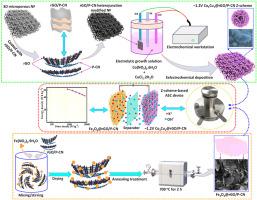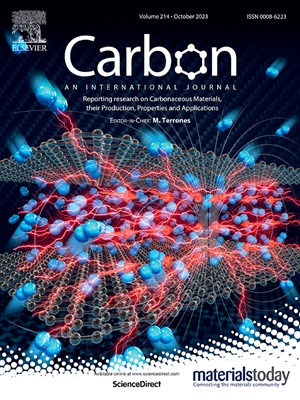用于超级电容器的限制 rGO/ 质子化 C3N5 结支撑 CoCu LDH 正极和 Fe3O4 负极的 Z 型异质结构
IF 10.5
2区 材料科学
Q1 CHEMISTRY, PHYSICAL
引用次数: 0
摘要
通过电沉积方法合理地定制了钴铜LDH稳定的还原氧化石墨烯-富N质子化C3N5(CoxCuy@rGO/P-CN)作为动力源Z型纳米复合材料。通过调节电沉积电位和 Co/Cu 摩尔比来调节电化学性能。因此,这为微调伪活性化合物的性能提供了令人信服的证据。得益于丰富的异质界面以及 LDH 纳米阵列和 rGO/P-CN 异质结之间的协同效应,分层-1.2V Co3Cu1@rGO/P-CN Z 型正极在 1 A g-1 电流条件下获得了 1184 F g-1 的较高电容和良好的速率性能。理论模拟结果表明,Co3Cu1@rGO/P-CN 纳米复合材料具有更高的电子电导率和更优越的电子转换能力,这源于价带和导带之间强有力的相互作用、界面电荷转移以及 LDH/rGO/P-CN 界面的内置电场。我们还通过简单的退火工艺探索了 Fe3O4@rGO/P-CN Z 型作为负电极材料的可能性,其在 1 A g-1 时的电容为 402 F g-1,循环性能也有所提高。因此,组装好的 -1.2V Co3Cu1@rGO/P-CN//Fe3O4@rGO/P-CN 不对称超级电容器 (ASC) 电池在 750 W kg-1 的条件下获得了 63.4 Wh kg-1 的显著能量密度,并显示出卓越的循环活性,在 11,000 次循环后仍能保持 88% 的电容量。本文章由计算机程序翻译,如有差异,请以英文原文为准。

Z-scheme heterostructures confining rGO/protonated C3N5 junction supported CoCu LDH positive electrode and Fe3O4 negative electrode for supercapacitors
CoCu LDH stabilized reduced graphene oxide-linked N-rich protonated C3N5 (CoxCuy@rGO/P–CN) as a power source Z-scheme nanocomposite was rationally tailored engineered an electrodeposition approach. The electrochemical performance was regulated by adjusting the electrodeposition potential and manipulating the Co/Cu molar ratio. Hence, affording compelling evidence for fine-tuning the performance of pseudo-active compounds. Benefiting from abundant heterointerfaces and synergistic effects between LDH nanoarrays and rGO/P–CN heterojunction, the hierarchical −1.2V Co3Cu1@rGO/P–CN Z-scheme positive electrode achieves a higher capacitance of 1184 F g−1 at 1 A g−1 and good rate capability performance. Theoretical simulation outcomes illustrate that the Co3Cu1@rGO/P–CN nanocomposite has higher electronic conductivity and superior electronic transition capability, originating from robust interactions between valence and conduction bands, interfacial charge transfer, and built-in electric field at the LDH/rGO/P–CN interface. We also explore the Fe3O4@rGO/P–CN Z-scheme as a negative electrode material via a simple annealing process with a capacitance of 402 F g−1 at 1 A g−1 and an enhanced cyclic performance. Consequently, the as-assembled −1.2V Co3Cu1@rGO/P–CN//Fe3O4@rGO/P–CN asymmetric supercapacitor (ASC) cell acquires a remarkable energy density of 63.4 Wh kg−1 at 750 W kg−1 and displays an exceptional cycling activity with 88 % retention after 11,000 cycles.
求助全文
通过发布文献求助,成功后即可免费获取论文全文。
去求助
来源期刊

Carbon
工程技术-材料科学:综合
CiteScore
20.80
自引率
7.30%
发文量
0
审稿时长
23 days
期刊介绍:
The journal Carbon is an international multidisciplinary forum for communicating scientific advances in the field of carbon materials. It reports new findings related to the formation, structure, properties, behaviors, and technological applications of carbons. Carbons are a broad class of ordered or disordered solid phases composed primarily of elemental carbon, including but not limited to carbon black, carbon fibers and filaments, carbon nanotubes, diamond and diamond-like carbon, fullerenes, glassy carbon, graphite, graphene, graphene-oxide, porous carbons, pyrolytic carbon, and other sp2 and non-sp2 hybridized carbon systems. Carbon is the companion title to the open access journal Carbon Trends. Relevant application areas for carbon materials include biology and medicine, catalysis, electronic, optoelectronic, spintronic, high-frequency, and photonic devices, energy storage and conversion systems, environmental applications and water treatment, smart materials and systems, and structural and thermal applications.
 求助内容:
求助内容: 应助结果提醒方式:
应助结果提醒方式:


